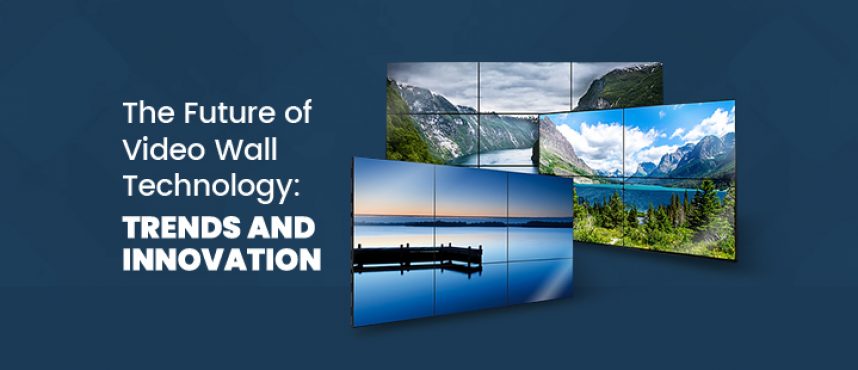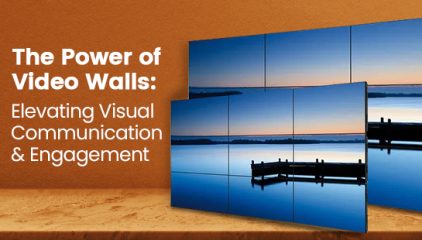The Future of Video Wall Technology: Trends and Innovation
Advancing Video Walls: The Future of Display Technology
Video walls have rapidly evolved from static displays to dynamic, interactive, and captivating installations that grab the attention of audiences in various settings, from retail spaces and control rooms to sports arenas and educational institutions. As technology continues to advance, the future of video wall technology promises exciting trends and innovations that will further transform the way we engage with information and entertainment. In this article, we’ll explore the trends and innovations shaping the future of video wall technology.
1. Ultra-Fine Pixel Pitch Displays:
Pixel pitch refers to the distance between each LED pixel on a display. In the future, we can expect to see even finer pixel pitches in video walls, resulting in higher resolution and image clarity. Ultra-fine pixel pitch displays will make it possible to create seamless video walls that appear as a single, cohesive screen, enhancing visual experiences in applications such as digital signage and home theaters.
2. MicroLED Technology:
MicroLED displays are made up of tiny, self-emissive microLEDs that offer vivid colors, high contrast ratios, and excellent energy efficiency. This technology is expected to revolutionize video walls, delivering exceptional image quality, low power consumption, and durability. MicroLED video walls are also modular, making it easier to scale and maintain displays.
3. Curved and Flexible Video Walls:
Curved and flexible video walls are pushing the boundaries of traditional flat displays. They can be customized to fit unique architectural designs and create immersive viewing experiences in museums, trade shows, and entertainment venues. Curved video walls are also used in simulators and gaming applications, adding a sense of realism.
4. Touch-Interactive Video Walls:
Interactive video walls are transforming the way we engage with information. Touch-sensitive displays enable users to interact with content, making them ideal for educational institutions, museums, and collaborative work environments. Multi-touch capabilities and gesture recognition are advancing, enhancing the interactive experience.
5. 3D and Holographic Displays:
The future holds promise for 3D and holographic video wall displays. These innovations will create stunning visual effects for entertainment, education, and advertising. 3D video walls, for instance, will allow viewers to perceive depth and dimension without the need for special glasses.
6. Augmented Reality (AR) Integration:
Video walls are beginning to integrate AR technologies, providing users with augmented information and experiences. This trend is particularly significant in retail and entertainment, where AR-enhanced content can influence consumer behavior and create memorable brand interactions.
7. Energy Efficiency and Sustainability:
As energy efficiency becomes a more significant concern, video wall technologies are evolving to consume less power while maintaining high brightness and quality. Additionally, sustainable materials and manufacturing practices are being integrated into video wall production, reducing environmental impact.
8. Advanced Content Management Systems:
Content management systems for video walls are becoming more sophisticated. AI-driven content automation and analytics are helping businesses personalize content delivery, optimize ad placements, and measure the effectiveness of their displays.
9. Cloud-Based Control and Management:
Video wall control and management are moving to the cloud. This allows for remote monitoring, control, and content updates from anywhere, making it easier for businesses to manage their video wall installations.
10. Enhanced Data Integration:
Video walls are increasingly being used to visualize and interact with complex data. Future developments will focus on seamlessly integrating data from various sources, creating dynamic, data-driven displays in fields such as finance, healthcare, and transportation.
11. Seamless Integration of Video Wall Technologies:
The future of video wall technology will involve smoother integration with other technologies, such as IoT devices, mobile apps, and smart home systems. This will enable users to control and interact with video walls using their smartphones or voice commands.
12. Personalization and User Recognition:
Innovations in facial recognition and user tracking will enable video walls to personalize content for viewers. Advertisers and content providers can tailor their messages to specific demographics or even individual preferences.
Conclusion:
The future of video wall technology is filled with exciting possibilities, driven by advancements in display technology, interactivity, energy efficiency, and data integration. These trends and innovations are reshaping how we experience visual content in diverse settings, from retail and entertainment to education and data analysis. As video walls become more accessible and versatile, we can expect to see these transformative technologies enriching our lives in ways we’ve yet to fully imagine.







